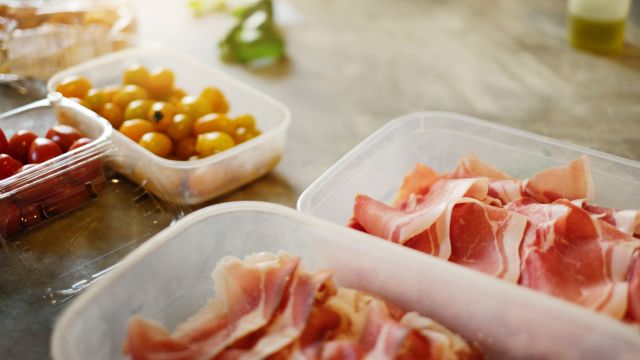Updated on May 27, 2022.
Are you worried about chemicals in hot dogs and plastic food containers? It could be the result of a policy statement published by the American Academy of Pediatrics (AAP) in the journal Pediatrics in July 2018. The statement and accompanying technical report warned about potential child health concerns related to certain food additives and packaging. The AAP took a step further on its social media feed, tweeting on August 1, 2018: “Parents, get rid of plastic food containers.”
A warning of this sort might leave parents calculating the expense of non-plastic replacements for food storage—and wondering just how dangerous plastics and certain types of foods are for their children.
The question is: Do you really need to replace everything in your kitchen?
What you need to know about chemicals in plastics
“We are recommending that families minimize the use of plastics for food,” says Rachel M. Shaffer, PhD, an author on the AAP’s policy statement and a toxicologist at the U.S. Environmental Protection Agency (EPA). “Heating food in plastic—in the microwave, for example—can promote the release of chemicals into the food.”
Some of these chemical compounds might affect thyroid and reproductive systems as well as metabolism (how your body converts food into energy). It’s worth keeping in mind, though, that for many chemicals, “might” is the best information available.
Because it’s not ethical to perform studies exposing people to these sorts of chemicals, most of the information about these substances’ possible effects comes from animal studies. And what human studies we do have usually involve showing a mathematical link between levels of a compound present in the blood or urine. It’s believed that exposure to the chemicals that certain plastics release over time can increase a person’s risk for some types of cancer and reproductive problems, according to the Endocrine Society.
How chemicals might influence health
Many of the compounds discussed in the AAP papers are used in plastic products to give them certain useful properties. For example, bisphenol A, or BPA, is present in some hard, clear plastics. Another plastic-associated class of chemicals called phthalates is used as a softener in products such as plastic wrap.
Studies show that exposure to these chemicals over time disrupt naturally occurring hormones and can negatively affect fertility in men and women. Men may experience a change in sperm quality and women who become pregnant may pass along these chemicals to the fetus, potentially causing developmental issues. Children exposed during growth in the womb run the risk of obesity when they grow up because the chemicals act like hormones that could trigger weight gain.
For an adult, these effects might be temporary, but during prenatal and early childhood development, the evidence is accumulating that these effects may become lifelong.
“We are particularly concerned about prenatal and early life exposures for children, especially during the first three years of life,” says Shaffer.
For an everyday example of how a chemical can differ in its effects at different life stages, consider alcohol. An adult can have a drink or two, or even binge on several drinks, and possibly experience nothing more than a bad headache the next morning. But exposure to alcohol during the fetal period can disrupt processes still in development for the brain and other systems, producing permanent changes.
What you can do about plastic products
Given the potential effects of these compounds, what can parents do when they are staring down mornings of packing school lunches and evenings of storing dinner leftovers?
The AAP policy statement emphasizes serving fresh and frozen fruits and vegetables as often as possible—and, as Shaffer notes, setting aside processed, packaged, or canned foods. The packaging for these types of foods often contains chemicals of concern. For example, the linings of cans that resist corrosion often contain BPA. One step you can take is to work on restocking your kitchen to use glass containers and stainless steel instead of plastic.
When making a wholesale shift away from plastic isn’t possible, says Shaffer, measures to reduce exposures “should be prioritized” during the prenatal period and the toddler years.
Parents can also consider the following recommendations from the policy statement:
Avoid processed meats, particularly during pregnancy. Cured meats—such as cold cuts and hot dogs—may contain nitrites and nitrates, which have been linked to disruption of thyroid hormone and to boosting levels of cancer-causing compounds. The only source of thyroid hormone for a developing embryo is the mother. Thyroid-disrupting effects from nitrates in a pregnant woman could disrupt thyroid hormone’s role in embryonic brain development. High levels of maternal intake of nitrates may even be tied to increased brain tumor risk in the child.
Avoid microwaving food or drink in plastics. The same goes for putting plastics in the dishwasher. The heat can cause the chemicals to leach out of the containers and into your food.
Learn the recycling codes and what they mean. These are the numbers printed in the triangles on the bottom of plastic products. A 3, 6, or 7 means the plastic contains chemicals you want to avoid: phthalates, styrene, and bisphenols, respectively. If, on the other hand, the plastic says “biobased” or “greenware,” that means it’s a product made from plants such as corn and doesn’t contain bisphenols.
Wash your hands before you eat. And wash all fruits and vegetables that can’t be peeled.
Regulatory changes could help, too
The AAP, which has a membership of 67,000 pediatricians, also has some advice for policy makers and the U.S. Food and Drug Administration (FDA). The FDA lists almost 4,000 food additives, but studies have looked at effects on reproduction for fewer than 300 of them and on human development for only two of them, the AAP reports.
What’s more, food manufacturers in the United States can add any of more than 10,000 chemicals to food. Many of these chemicals aren’t FDA approved and are designated as safe only by interested parties—in many cases, the manufacturers themselves or consultants they have hired. The AAP policy statement says that the current requirements for considering an additive safe are “insufficient” and calls for a complete overhaul of how these additives are evaluated, regulated, and labeled.







